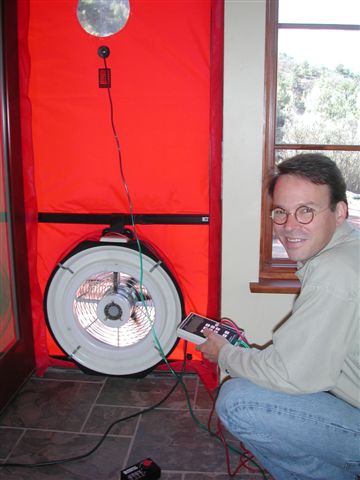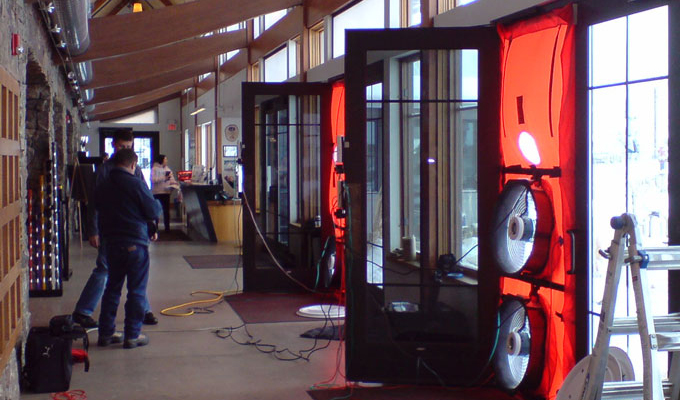What does it mean for the Builder?
What is a Blower Door Test? It is also called an air-leakage or infiltration test. It measures the air that moves through a building envelope at a standard pressure difference.

The blower door itself is a device with a large fan that is used to push air out of the building through the building envelope. The resulting vacuum draws air in though the envelope and the rate can be measured by the blower door. During the test, the manometer, which is the brains of the blower door displays a number, which is the flow in CFM (cubic feet per minute) at a given standard test pressure. This raw number must be adjusted to compensate for altitude and the density differences of different temperature air inside and outside. This number is then used to calculate even more numbers, that we can use to compare the tightness/leakiness of different buildings to each other and to a standard.
Two common metrics for comparing leakage exchange rates are ACH50 (Air Changes per Hour at 50 Pascals) and CFM/SF75 (Cubic Feet per Minute per Square Foot at 75 Pascals).
ACH50: if you are building a house under the 2009 IECC (International Energy Conservation Code) the maximum allowed air changes per hour at 50 Pascals is 7. To calculate the ACH50 from the CFM50 given by the blower door we need to know the volume of the building. Multiply the flow by 60 to convert to hours, then divide by the volume. (ACH50 = airflow (CFM50) X 60 / conditioned volume) If the number is under 7 then it is a pass. In the 2012 IECC the limit jumps to 3 ACH50. That is tight, but the goal to become a certified Passive House is .6 ACH50!
CFM/SF75: if you are working on a commercial project under the IECC or IgCC, you will see a requirement like this; leakage must be under .40 CFM/FT² (2012 IECC) or .25 CFM/FT² (2012 IgCC) at 75 Pascals . Under this metric you need to know the surface area of the building envelope. Multiply that by standard rate to find the allowable leakage flow at 75 Pascals. If the blower door measures a flow less than the allowable, then it’s a pass.
How long does the test take? If the building is setup (i.e. windows closed and mechanical systems shut down) it takes only a few minutes to assemble the blower door. The test takes only a moment if no problems are encountered. If the goal is to find leaks and seal them, then this is the time to walk the building and search of leaks with an infrared camera, smoke or a hand.
When is the building ready to be tested? Technically a building can be tested as soon as there is enough of an envelope to pressurize. If the test is at rough, then incomplete flues and missing door hardware can be temporarily taped over. If the test is at final, and the goal is to get the best score possible, then put off the test until the hardware, fixtures and switch covers are in place. Although workers may be present for the blower door test, all exterior doors need to be closed and stay closed for the duration of the test.
What is blower door directed air sealing? Running a blower door continuously to find and seal leaks as they are found in an existing building.
Why is air sealing important? As it turns out, air infiltration is typically the single most important way to same energy in a building, and it’s relatively cheap and easy to do, and it also increases building comfort and durability.
How does the builder have an affect on the tightness of the building envelope? Through insulation choices, attention to sealing details, mechanical system choices, etc.
How can the score be improved? Let’s talk about the house. We can provide advice, details and specifications to help you minimize air infiltration.
Now the building is so tight, I have to add mechanical ventilation; isn’t that just silly? Its all about control. It’s true we have to exchange some air to keep the Indoor Air Quality high, and some heat will go with in. But if all of that air moves through a mechanical system, then it can be controlled and conditioned. With the help of an ERV or HRV a great deal of the heat can be captured and put back into the building. It is also an opportunity to filter the incoming air with a high performance air filter instead of that air being drawn through unclean cracks and gaps. Also, if the infiltration moves though the insulation, the insulation loses part of it’s ability to resit heat loss.
How much does a blower door test cost? Confluence charges $250 for tests in Glenwood Springs, Carbondale, Basalt, Snowmass and Aspen Colorado. Contact us for quote outside of that area. Fees increase if additional equipment is required because the building is very large. We provide you with a report for the Owners and the building department with the test results within 24 hours.
How do I schedule a blower door test? Just give us a call or email. Ample notice is appreciated.
